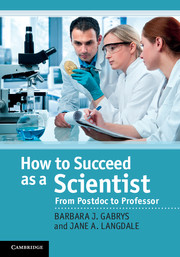Part II - Thriving in your new job
Published online by Cambridge University Press: 05 November 2011
Summary
Thriving in your new job
Your living is determined not so much by what life brings to you as by the attitude you bring to life; not so much by what happens to you as by the way your mind looks at what happens.
Kahlil GibranThe first part of this book concentrated on establishing yourself as an independent scientist who can confidently communicate your research, to the extent that you can secure a position as a principal investigator (PI). In this section we focus on working with others and on building your research group. In the first chapter (Chapter 10) we look at ways to understand your personality profile – this knowledge will help you learn how best to interact with others. You can also learn from those who have gone before you, and in Chapter 11 we hear from some young PIs about their experiences of the postdoc–PI transition. We then turn to the thorny issue of managing people (Chapter 12), and on to recruiting and supervising PhD students (Chapter 13) and postdocs (Chapter 14). Partly because scientists have no formal management training, but also because research is very difficult to carry out unless there is a degree of harmony in the research team, the ability to manage people can make or break a young PI’s career. Similarly, the way in which you interact with others through networking and collaboration, and the extent to which you contribute to the scientific community can influence how you and your research is perceived. We discuss how to make the most of networking and collaborations in Chapter 15. Teaching and learning figure prominently in the final four chapters both in formal classroom settings (Chapters 16,17 and 18) and in the mentoring process (Chapter 19).
- Type
- Chapter
- Information
- How to Succeed as a ScientistFrom Postdoc to Professor, pp. 97 - 98Publisher: Cambridge University PressPrint publication year: 2011



